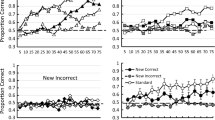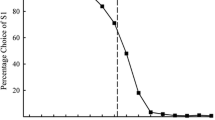Abstract
In a two-stimulus visual discrimination task with a reversal in reward contingencies midway through each session, pigeons produce a surprising number of both anticipatory (i.e., before the reversal) and perseverative (i.e., after the reversal) errors. In the current work, we examined pigeons’ (Columba livia) patterns of responding on a 90-trial, three-stimulus visual or spatial discrimination task with two changes in reward contingency (one after Trial 30 and one after Trial 60) during each session. On probe sessions where pecking the first-correct stimulus was rewarded for the first 60 rather than 30 trials, pigeons on a spatial discrimination pecked the first-correct stimulus until it was no longer rewarded, while visual discrimination birds ceased responding to the first-correct stimulus even while it was still being rewarded. On probe sessions where the onset of the first trial was delayed 7 min, pigeons’ performance on the visual discrimination was disrupted by the interval delay, but performance in the spatial condition was more similar to baseline. Pigeons use different strategies (temporal control vs. local reinforcement) on midsession reversal tasks with visual versus spatial stimuli, suggesting that they are selectively permeable to changes in information (global vs. local reinforcement rates).





Similar content being viewed by others
References
Biebach H, Gordijn M, Krebs JR (1989) Time-and-place learning by garden warblers, Sylvia borin. Anim Learn Behav 14:241–248
Biebach H, Falk H, Krebs JR (1991) The effect of constant light and phase shifts on a learned time-place association in garden warblers (Sylvia borin): hourglass or circadian clock? J Biol Rhythm 6:353–365
Carr JAR, Wilkie DM (1997) Ordinal, phase, and interval timing. In: Bradshaw CM, Szabadi E (eds) Time and behaviour: psychological and neurobehavioural analyses. Elsevier Science B.V, Amsterdam, pp 265–329
Cook RG, Rosen HA (2010) Temporal control of internal states in pigeons. Psychon Bull Rev 17:915–922
Crystal JD (2009) Theoretical and conceptual issues in time-place discrimination. Eur J Neurosci 30:1756–1766
Daan S, Koene P (1981) On the timing of foraging flights by oystercatchers, Haematopus ostralegus, on tidal mudflats. Neth J Sea Res 15:1–22
Gibbon J (1977) Scalar expectancy theory and Weber’s law in animal timing. Psychol Rev 84:279–325
Laude JR, Stagner JP, Rayburn-Reeves RM, Zentall TR (2014) Midsession reversals with pigeons: visual versus spatial discriminations and the intertrial interval. Learn Behav 42:40–46
Macar F, Vidal F (2009) Timing processes: an outline of behavioral and neural indices not systematically considered in timing models. Can J Exp Psychol 63:227–239
McMillan N, Kirk CR, Roberts WA (in press) Pigeon and rat performance in the midsession reversal procedure depends upon cue dimensionality. J Comp Psychol
McMillan N, Roberts WA (2012) Pigeons make errors as a result of interval timing in a visual, but not visual-spatial, midsession reversal task. J Exp Psychol Anim Behav Process 38:440–445
McMillan N, Roberts WA (2013) Pigeons rank-order responses to temporally sequential stimuli. Learn Behav 41:309–318
Pizzo MJ, Crystal JD (2002) Representation of time in time-place learning. Anim Learn Behav 30:387–393
Rayburn-Reeves RM, Zentall TR (2013) Pigeons’ use of cues in a repeated five-trial-sequence, single-reversal task. Learn Behav 4:138–147
Rayburn-Reeves RM, Molet M, Zentall TR (2011) Simultaneous discrimination reversal learning in pigeons and humans: anticipatory and perseverative errors. Learn Behav 39:125–137
Rayburn-Reeves RM, Laude JR, Zentall TR (2013a) Pigeons show near-optimal win-stay/lose-shift performance on a simultaneous-discrimination, midsession reversal task with short intertrial intervals. Behav Process 92:65–70
Rayburn-Reeves RM, Stagner JP, Kirk CR, Zentall TR (2013b) Reversal learning in rats (Rattus norvegicus) and pigeons (Columba livia): qualitative differences in behavioral flexibility. J Comp Psychol 127:202–211
Roberts WA (1972) Short-term memory in the pigeon: effects of repetition and spacing. J Exp Psychol 94:74–83
Stagner JP, Michler DM, Rayburn-Reeves RM, Laude JR, Zentall TR (2013) Midsession reversal learning: why do pigeons anticipate and perseverate? Learn Behav 41:54–60
Wilkie DM (1995) Time-place learning. Curr Dir Psychol Sci 4:85–89
Acknowledgments
This research was supported by a Discovery Grant from the Natural Sciences and Engineering Research Council of Canada to W. A. Roberts. We thank Chelsea Kirk and Krista Macpherson for assistance in running subjects, and Jacek Majewski for animal care.
Conflict of interest
The authors declare they have no conflict of interest.
Ethical standard
This research was conducted with the approval of the University of Western Ontario Animal Use Subcommittee, meeting the standards of the Canadian Council on Animal Care.
Author information
Authors and Affiliations
Corresponding author
Rights and permissions
About this article
Cite this article
McMillan, N., Roberts, W.A. A three-stimulus midsession reversal task in pigeons with visual and spatial discriminative stimuli. Anim Cogn 18, 373–383 (2015). https://doi.org/10.1007/s10071-014-0808-2
Received:
Revised:
Accepted:
Published:
Issue Date:
DOI: https://doi.org/10.1007/s10071-014-0808-2




